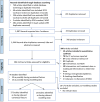Mass Drug Administration: Contextual Factor Considerations
- PMID: 38266300
- PMCID: PMC10993792
- DOI: 10.4269/ajtmh.22-0767
Mass Drug Administration: Contextual Factor Considerations
Abstract
In designing mass drug administration (MDA) campaigns, it is imperative to consider contextual factors that affect uptake of the intervention, including acceptability, cost, feasibility, and health system considerations, to ensure optimal coverage. We reviewed the literature on contextual factors influencing MDA delivery to provide programs with information to design a successful campaign. From 1,044 articles screened, 37 included contextual factors relevant to participants' values and preferences, drivers of MDA acceptability, health equity concerns, financial and economic aspects, and feasibility barriers; 13 included relevant modeling data. Key findings were abstracted by two reviewers and summarized. No studies directly assessed values or direct health equity concerns with respect to MDA, which represents an evidence gap as unequal distributions of effects and factors that impact participant acceptability and program feasibility must be considered to ensure equitable access. Participant acceptability was the most widely surveyed factor, appearing in 28 of 37 studies; perceived adverse events were a frequently noted cause of nonparticipation, mentioned in 15 studies. Feasibility considerations included when, where, and how drugs will be delivered and how to address pregnant women, as these can all have substantial implications for participation. Mass drug administration costs (∼$1.04 to $19.40 per person per round) are driven primarily by drug prices, but the delivery mechanism can have varying costs as well, and integration with other interventions may provide cost savings. Both programmatic goals and sociopolitical and economic contexts must be carefully considered before embarking on an MDA program to ensure programmatic success.
Conflict of interest statement
Disclosure: The findings and conclusions in this report are those of the authors and do not necessarily represent the official position of the U.S. Centers for Disease Control and Prevention.
Figures
References
-
- World Health Organization , 2021. WHO Malaria Terminology. Geneva, Switzerland: WHO. Available at: https://www.who.int/publications/i/item/9789240038400. Accessed October 2, 2023.
-
- Okell L, Pemberton-Ross P, Wenger E, 2015. Consensus Modelling Evidence to Support the Design of Mass Drug Administration Programmes. Malaria Policy Advisory Committee Meeting, September 16-18, 2015, Geneva, Switzerland.
Publication types
MeSH terms
Grants and funding
LinkOut - more resources
Full Text Sources
Miscellaneous


